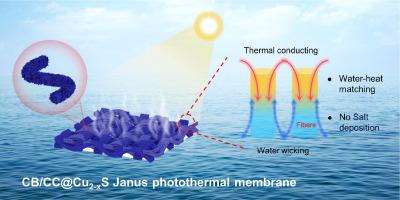无缝集成的柔性Janus膜使水-热-盐协同作用用于太阳能脱盐和废水处理
IF 14.9
1区 化学
Q1 Energy
引用次数: 0
摘要
太阳能驱动的界面蒸发为解决全球淡水短缺问题提供了一种很有前途的方法。目前光热膜设计的挑战在于同时优化高太阳能吸收率、低导热率和水输输,而现有材料未能在蒸发界面建立有效的“水-热-盐”协同调节。本研究通过在带有炭黑涂层(CB/CC)的疏水碳布基底上生长亲水性Cu2−xS纳米结构,开发了无缝集成的Janus膜。通过精确设计Cu2−xS层内的亚微米孔隙结构,我们建立了界面水输送、热管理和盐抑制的协同优化机制。得到的Janus膜在一个太阳下的蒸发速率为2.22 kg m−2 h−1,能量效率约为88.4%。值得注意的是,该系统在高盐环境(20wt % NaCl)中保持稳定运行,并实现连续5小时的耐盐蒸发。此外,Janus膜可以有效地净化各种工业废水,包括酸性、碱性和有机污染物。本研究通过孔隙结构界面工程为开发高效便携式海水淡化系统提供了一种新的策略。本文章由计算机程序翻译,如有差异,请以英文原文为准。

Seamlessly integrated flexible Janus membranes enabling water-heat-salt synergy for solar desalination and wastewater treatment
Solar-driven interfacial evaporation presents a promising approach to address global freshwater scarcity. Current challenges in photothermal membrane design lie in achieving concurrent optimization of high solar absorption, low thermal conductivity, and water transport, where existing materials fail to establish effective “water-heat-salt” synergistic regulation at the evaporation interface. This study develops a seamlessly integrated Janus membrane through growing hydrophilic Cu2−xS nanostructure on a hydrophobic carbon cloth substrate with carbon black coating (CB/CC). By precisely engineering the submicron pore architecture within the Cu2−xS layer, we established a synergistic optimization mechanism for interfacial water transport, heat management, and salt rejection. The resulting Janus membrane demonstrates a high evaporation rate of 2.22 kg m−2 h−1 under 1 sun with an energy efficiency of about 88.4 %. Notably, the system maintains stable operation in hypersaline environments (20 wt% NaCl) and achieves continuous 5-h salt-resistant evaporation. Moreover, the Janus membranes can effectively purify various industrial wastewater, including acidic, alkaline, and organic pollutants. This study provides a new strategy for developing high-efficiency portable desalination systems through interfacial engineering of pore architecture.
求助全文
通过发布文献求助,成功后即可免费获取论文全文。
去求助
来源期刊

Journal of Energy Chemistry
CHEMISTRY, APPLIED-CHEMISTRY, PHYSICAL
CiteScore
19.10
自引率
8.40%
发文量
3631
审稿时长
15 days
期刊介绍:
The Journal of Energy Chemistry, the official publication of Science Press and the Dalian Institute of Chemical Physics, Chinese Academy of Sciences, serves as a platform for reporting creative research and innovative applications in energy chemistry. It mainly reports on creative researches and innovative applications of chemical conversions of fossil energy, carbon dioxide, electrochemical energy and hydrogen energy, as well as the conversions of biomass and solar energy related with chemical issues to promote academic exchanges in the field of energy chemistry and to accelerate the exploration, research and development of energy science and technologies.
This journal focuses on original research papers covering various topics within energy chemistry worldwide, including:
Optimized utilization of fossil energy
Hydrogen energy
Conversion and storage of electrochemical energy
Capture, storage, and chemical conversion of carbon dioxide
Materials and nanotechnologies for energy conversion and storage
Chemistry in biomass conversion
Chemistry in the utilization of solar energy
 求助内容:
求助内容: 应助结果提醒方式:
应助结果提醒方式:


